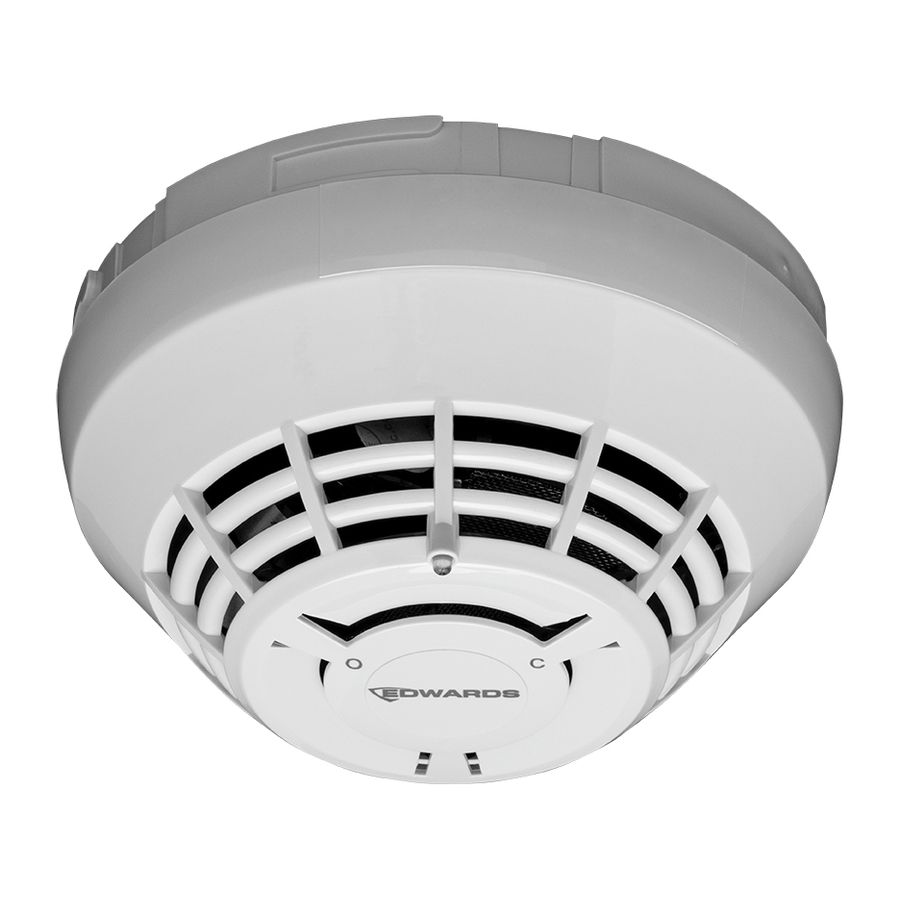
Advertisement
Quick Links
KI-PCD Intelligent Photoelectric
Smoke Detector with CO Sensor
Installation Sheet
Description
The model KI-PCD Intelligent Photoelectric Smoke Detector with CO
Sensor is an intelligent device that uses an optical sensing chamber to
detect smoke, and a CO sensor to detect carbon monoxide from any
source of combustion. The detector analyzes the smoke and CO
sensors independently to determine whether to initiate a fire alarm, a
life safety CO alarm, or both.
LED indicator.
The LED indicator (see Figure 1) displays the following
states:
•
Normal: Green LED indicator flashes, no action.
•
Alarm/active: Red LED indicator flashes, evacuate the area.
Sensor end-of-life indicator:
The detector signals a "COMMON TRBL ACT" condition on the control
panel when the CO sensor reaches its end of life. Pressing the Details
button on the control panel displays "END OF LIFE ACT" providing
verification that it is an end-of-life trouble of the CO sensor. This
trouble remains active until the detector is replaced, even if the panel is
reset.
Figure 1: KI-PCD features
(1)
(1) Self-locking tab
(2) LED indicator
© 2018 United Technologies Corporation
Installation
Notes
•
This detector does not sense fires in areas where smoke cannot
reach the detector. Smoke from fires in walls, roofs, or on the
opposite side of closed doors may not reach the detector.
•
This detector does not detect oxygen levels or flames. Use this
device as part of a broad-based life safety program which includes
a variety of information sources pertaining to heat and smoke
levels, extinguishment systems, visual and audible devices, and
other safety measures.
•
Photoelectric detectors have a wide range of fire-sensing
capabilities and are best suited for detecting slow, smoldering fires.
•
To ensure proper operation, store the detector within the
recommended ranges. Allow the detector to stabilize to room
temperature before applying power.
•
The dust cover (supplied) must remain on the detector during
installation and be removed prior to commissioning and service.
The dust cover is not a substitute for removing the detector during
new construction or heavy remodeling.
•
Do not install detectors until after final construction cleanup (unless
otherwise specified by the AHJ).
•
Do not use smoke detectors with detector guards unless the
combination has been evaluated and found suitable.
•
Install per NFPA 72 National Fire Alarm and Signaling Code,
NFPA 720 Standard for the Installation of Carbon Monoxide (CO)
Detection and Warning Equipment, and UL 2075 Standard for Gas
and Vapor Detectors and Sensors.
•
Upon completion of the original installation and following any
modifications or additions to the system, perform a calibrated
sensitivity test per NFPA code. The Signature Series can perform
this test and generate a system sensitivity report.
To install the detector:
1. Install and wire the base, as described on the installation sheet
supplied with the base.
2. Remove the serial number label from the detector and attach it to
the project documentation.
3. Attach the detector to the base by rotating the detector clockwise
until it snaps into the locked position.
4. If required by the AHJ or local codes, affix the supplied CO
Warning Label (P/N 3303928) in proximity to the detector.
(2)
1 / 4
P/N 3102469-EN • REV 003 • 04JUN18
Advertisement

Summary of Contents for Kidde KI-PCD
- Page 1 Description • Do not use smoke detectors with detector guards unless the The model KI-PCD Intelligent Photoelectric Smoke Detector with CO combination has been evaluated and found suitable. Sensor is an intelligent device that uses an optical sensing chamber to detect smoke, and a CO sensor to detect carbon monoxide from any •...
- Page 2 Carbon monoxide alarm procedure Many cases of reported CO poisoning indicate that while victims are aware they are not well, they become so disoriented that they are unable to save themselves by either exiting the building or calling for WARNING: The carbon monoxide (CO) alarm indicates the presence assistance.
- Page 3 The recommended CO detector locations are: To perform CO sensor function tests: • Outside each separate sleeping area in the immediate vicinity of 1. Use the fire alarm control panel to put the detector into accelerated the bedrooms (including areas such as hotel rooms and dorm response mode.
- Page 4 Specifications Operating voltage 15.20 to 19.95 VDC Current Normal operating 51 µA Alarm 68 µA Vibration level 10 to 35 Hz, with an amplitude of 0.01 in. Wall mount distance from 12 in. (305 mm) max. ceiling Compatible bases Standard KI-SB, KI-SB4, GSA-SB, GSA-SB4 Relay KI-RB, KI-RB4, GSA-RB...








